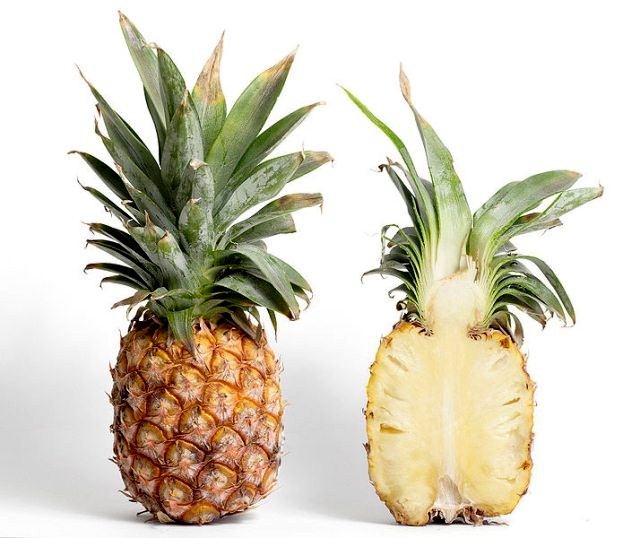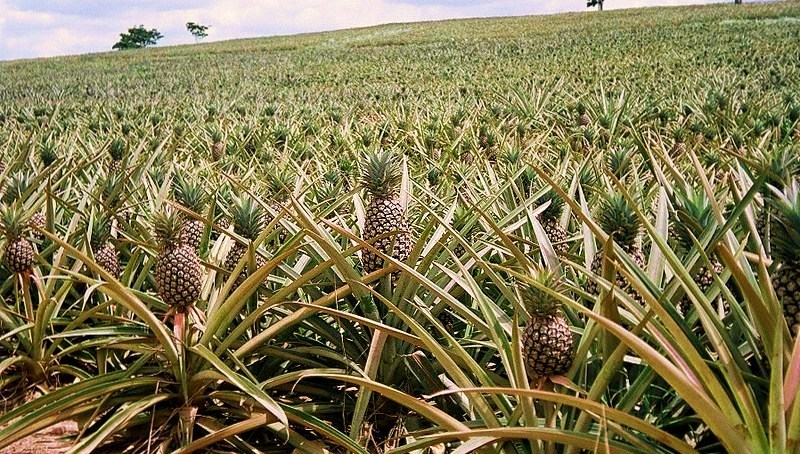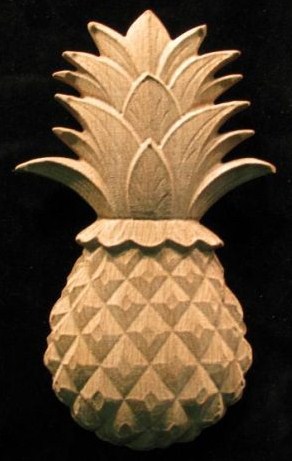Pineapples

|
The Pineapple
In Victorian England a pineapple would be ‘hired’ to take to parties, to be marvelled at, show the wealth of the person arriving with it and as a unique topic of conversation. Kew Gardens in London has been key in producing cross-bred fruits for sweetness. We see them everywhere we go in the Caribbean, pick-up trucks becoming impromptu market stalls, each and every supermarket, fruit market and fields growing them. The funniest thing for us is when we buy (as a treat for Bear who calls them Lush) one at four pounds fifty imported from Ecuador and on our latest trip to the UK bought the very same thing for ninety nine pence in Tesco. What’s the story there???

The Pineapple (Ananas comosus) is
the common name for an edible tropical plant and its edible fruit which are coalesced berries. Pineapples are the only bromeliad fruit in widespread cultivation. It can be grown as an ornamental,
especially from the leafy tops but will not fruit. Pineapple is eaten fresh or canned or juiced. It is popularly used in
desserts, salads, as a complement to meat dishes and in fruit
cocktail. The popularity of the pineapple is due to its sweet-sour taste
containing 15% sugar and malic and citric fruit acids. It is also high in
vitamin B1, B2, B6 and C. The protein digesting enzyme bromelin seems to help
digestion at the end of a high protein meal. Etymology: The word pineapple in English was first recorded in 1398, when it was originally used to describe the reproductive organs of conifer trees (now termed pine cones). When European explorers discovered this tropical fruit, they called them pineapples (term first recorded in that sense in 1664) because of their resemblance to what is now known as the pine cone. The term pine cone was first recorded in 1694 and was used to replace the original meaning of pineapple. In the scientific binomial Ananas comosus, ananas, the original name of the fruit, comes from the Tupi (Rio de Janeiro, Brazil) word for pine nanas, as recorded by André Thevenet in 1555 and comosus means "tufted" and refers to the stem of the fruit. Other members of the Ananas genus are often called pine as well by laymen. Many languages use the Tupian term ananas. In Spanish, pineapples are called piña "pine cone" in Spain and most Hispanic American countries, or ananá (ananás in Argentina) (see the piña colada drink). They have varying names in the languages of India: "Anaasa" in telugu, annachi pazham (Tamil), anarosh (Bengali), and in Malayalam, kaitha chakka. In Malay, pineapples are known as "nanas" or "nenas". In the Maldivian language of Dhivehi, pineapples are known as alanaasi. A large, sweet pineapple grown especially in Brazil is called abacaxi.

Botany: The pineapple is an herbaceous short-lived perennial
plant which grows to three to five feet tall. The plant only produces one
fruit and then dies, commercially suckers are cultivated. It has thirty or more
fleshy, trough-shaped leaves with sharp spines along the margins, a foot to
three feet long, surrounding a thick stem. In the first year of growth the axis lengthens and thickens bearing
numerous leaves in close spirals. After twelve to twenty four months the stem
grows into a spike-like inflorescence up to six inches long with over a hundred
spirally arranged, trimerous flowers each subtended by a bract. Flower colours
vary, depending on variety, from lavender through light purple to red.
The ovaries develop into berries which coalesce into a large compact,
multiple accessory fruit. The fruit of a pineapple is arranged in two
interlocking helices, eight in one direction, thirteen in the other, each being
a Fibonacci
number. Pineapple carries out CAM
photosynthesis fixing carbon dioxide at night and storing it as the acid malate and
then releasing it during the day, aiding photosynthesis. Pollination: Pollination is required for seed formation, but the presence of seeds negatively affects the quality of the fruit. In Hawaii, where pineapple is cultivated on an agricultural scale, importation of hummingbirds is prohibited for this reason. Certain bat-pollinated wild pineapples only open their flowers at night.

Charles II presented with the first pineapple grown in
England (1675 painting by Hendrik Danckerts)
Nutrition: Pineapple is a good source of manganeseas well as containing significant amounts of vitamin C and vitamin B1. Pineapple contains a proteolytic enzyme bromelain, which breaks down protein. Pineapple juice can thus be used as a marinade and tenderiser for meat. The enzymes in raw pineapples can interfere with the preparation of some foods, such as jelly or other gelatin-based desserts but it breaks down in cooking or the canning process. Though some have claimed pineapple should not be consumed by people with Ehlers Danlos Syndrome, or kidney or liver disease the quantity of bromelain in the fruit is probably not medically significant being mostly in the inedible stalk. Consumers of pineapple have claimed that pineapple has benefits for some intestinal disorders, others believe it serves as a pain reliever and some that it helps to induce childbirth when a baby is overdue.

The Spread of Pineapple: The natives of southern Brazil and Paraguay spread the pineapple throughout South America, and it eventually reached the Caribbean. Columbus discovered it in the Indies and brought it back with him to Europe. The Spanish introduced it into the Philippines, Hawaii (introduced in the early 19th century, first commercial plantation 1886), Zimbabwe and Guam. The fruit was cultivated successfully in European hothouses, and pineapple pits, beginning in 1720. The pineapple was introduced to Hawaii in 1813; exports of canned pineapples began in 1892. Large scale pineapple cultivation by U.S. companies began in the early 1900s on Hawaii. Among the most famous and influential pineapple industrialists was James Dole, who started a pineapple plantation in Hawaii in the year 1900. The companies Dole and Del Monte began growing pineapple on the island of Oahu in 1901 and 1917, respectively. Maui Pineapple Company began pineapple cultivation on the island of Maui in 1909. In 2006, Del Monte announced its withdrawal from pineapple cultivation in Hawaii, leaving only Dole and Maui Pineapple Company in Hawaii as the USA’s largest growers of pineapples. Maui Pineapple Company markets its Maui Gold brand of pineapple and Dole markets its Hawaii Gold brand of pineapple. In the USA in 1986, the Pineapple Research Institute was dissolved and its assets were divided between Del Monte and Maui Land and Pineapple. Del Monte took variety 73-114, which it dubbed MD-2, to its plantations in Costa Rica, found it to be well-suited to growing there, and launched it publicly in 1996. (Del Monte also began marketing 73-50, dubbed CO-2, as Del Monte Gold). In 1997, Del Monte began marketing its Gold Extra Sweet pineapple, known internally as MD-2. MD-2 is a hybrid that originated in the breeding program of the now-defunct Pineapple Research Institute in Hawaii, which conducted research on behalf of Del Monte, Maui Land & Pineapple Company, and Dole.

Cultivation: Southeast
Asia dominates world production: in 2001 Thailand produced 1.979 million tons and the Philippines 1.618 million tons, while in the Americas Brazil produced 1.43 million tons. Total world production in 2001 was
14.220 million tons. The primary exporters of fresh pineapples in 2001 were
Costa
Rica, 322,000 tons; Côte
d'Ivoire, 188,000 tons; and the Philippines, 135,000 tons. Since about 2000, the most common
fresh pineapple fruit found in the US and the European supermarkets is a
low-acid hybrid that was developed in Hawaii in the early 1970’s. In commercial farming, flowering can be induced artificially, and the
early harvesting of the main fruit can encourage the development of a second
crop of smaller fruits. Once removed during cleaning, the top of the pineapple
can be planted in soil and a new plant will grow. Slips and suckers are planted
commercially. Cultivars: There are many cultivars. The leaves of the commonly grown 'Smooth Cayenne' are smooth, and is the most
commonly grown worldwide. Many cultivars have become distributed from its
origins in Paraguay and the southern part of Brazil, and later improved stocks were introduced into the Americas, the
Azores, Africa, India, Malaysia and Australia. Varieties
include:
Ethno-medical usage: Both the root and fruit are sometimes eaten or applied topically as an anti-inflammatory and as a proteolytic agent. It is traditionally used as an antihelminthic agent in the Philippines. Pests and diseases: Pineapples are subject to a variety of diseases, the most serious of
which is wilt disease vectored by mealybugs. The mealybugs are generally found on the surface of pineapples, but
can also be found inside the closed blossom cups. Other diseases include pink
disease, bacterial heart
rot, and anthracnose. Storage and transport: Fresh pineapple is delicate and because they are chill-sensitive they are not refrigerated. They are transported with the crowns downwards. Some buyers prefer green fruit, others ripened or off-green. A plant growth regulator Ethephon is typically sprayed onto the fruit one week before harvest, developing ethylene, which turns the fruit golden yellow. After cleaning and slicing they are typically canned in sugar syrup with added preservative. For home use, green pineapples will ripen naturally at room temperature, though they can quickly over ripen.
 
In culture: The pineapple has become associated with the notion of welcome, an association bespoken by the use of pineapple motifs as carved decorations in woodworking.
ALL IN ALL A UNIQUE LOOKING THING LUSH |
